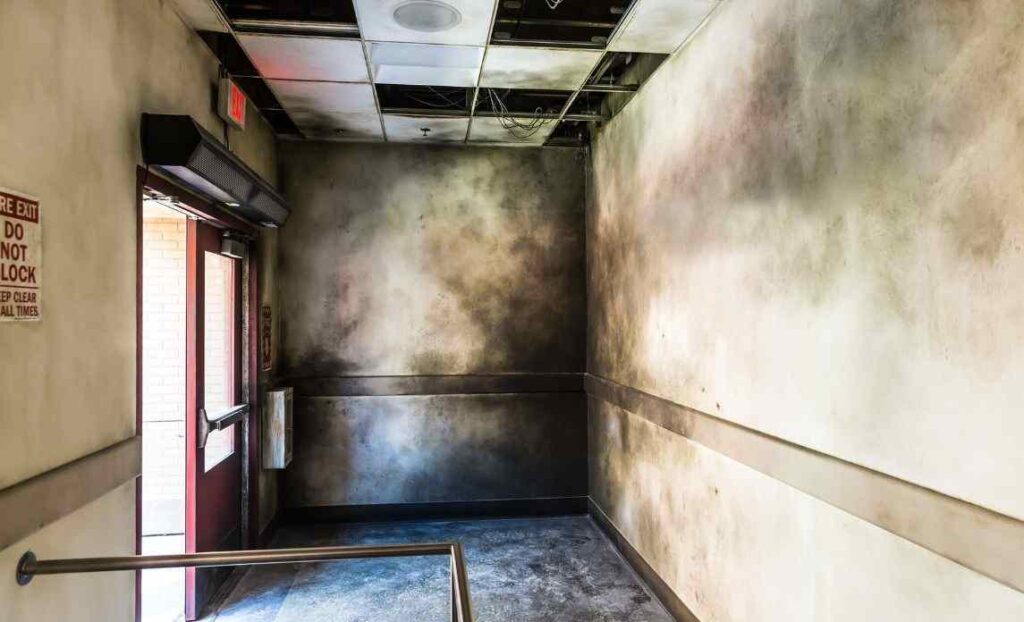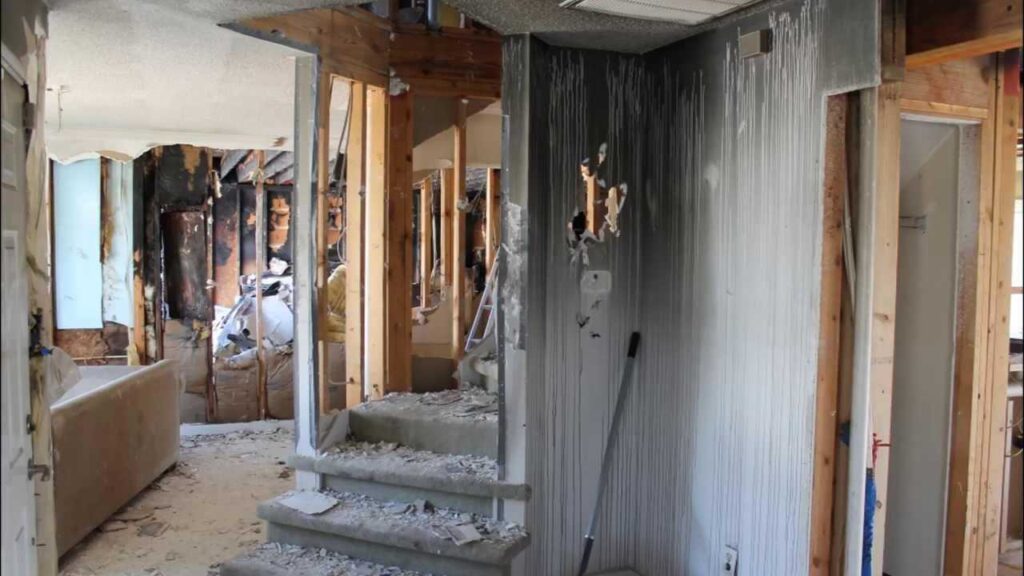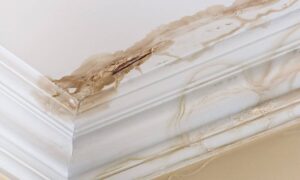Blogs
Plano Homeowners: Should You Attempt DIY Fire Damage Restoration?

Fire damage restoration is a crucial, complex process for homeowners recovering from the devastation of a house fire. Many Plano residents might wonder whether they should handle restoration themselves to save money and speed up the process. However, fire damage restoration involves more than just cleaning; it includes understanding structural safety, health risks from smoke, and proper handling of damaged materials. In this guide, Intensa Dry explores the key factors to consider when deciding between DIY and professional restoration, providing essential insights into the restoration process. Armed with this information, Plano homeowners can make an informed, safe choice for their property’s recovery.
Understanding the Fire Damage Restoration Process
Restoring a home after a fire is a multi-stage process requiring careful planning and execution. The first step is assessing the damage, including the structural stability of walls, ceilings, and floors, as well as potential smoke or water damage from firefighting efforts. Next comes cleaning and removing damaged materials like soot-stained walls, charred wood, and melted insulation. Specialized equipment and products are often necessary for effectively removing smoke odor and soot particles, which can infiltrate carpets, walls, and even the air ducts. Proper fire damage restoration also addresses health risks, as fire residues contain chemicals that may pose respiratory hazards. DIY attempts should only be made with a comprehensive understanding of these steps.
The Dangers of Incomplete Fire Damage Restoration
One significant risk of DIY fire damage restoration is the possibility of incomplete work, which can lead to long-term damage. Soot, ash, and smoke can settle deep into walls, furniture, and flooring. Left untreated, these residues can cause permanent staining, corrosion, and even structural deterioration. Another danger is the presence of toxic chemicals released during the fire; these can affect indoor air quality and cause health issues if not fully removed. Without the right tools and expertise, homeowners may miss critical areas or fail to completely eliminate harmful substances. Proper, thorough restoration is essential to prevent these hidden risks from escalating.
Health Risks Associated
The aftermath of a fire often includes lingering smoke particles, soot, and chemicals that pose serious health hazards. Inhaling or coming into contact with these substances can lead to respiratory issues, skin irritation, and other health concerns. Without protective gear and specialized knowledge, homeowners risk exposure to toxic substances like formaldehyde, ammonia, and other volatile organic compounds. Furthermore, disturbing these particles during cleanup can increase the risk of airborne contaminants, further endangering household members. For Plano homeowners considering a DIY approach, it’s essential to be aware of these health risks and take appropriate measures to protect their families.
Necessary Equipment and Supplies

A successful DIY fire damage restoration requires access to proper equipment and supplies, many of which are specialized and not commonly found in the average household. Key tools include industrial-grade air scrubbers, respirators, HEPA vacuums, and high-quality cleaning agents formulated to neutralize soot and smoke residue. Additionally, personal protective equipment (PPE), such as gloves, masks, and goggles, is essential to protect against exposure to toxic materials. Plano homeowners should be prepared to invest in or rent these tools if they choose to handle restoration themselves. Having access to the right equipment can make a significant difference in ensuring a thorough and safe cleanup.
Time and Cost Considerations
While DIY fire damage restoration may seem cost-effective, it can be more time-consuming and potentially costly than anticipated. DIY projects require thorough research, planning, and hands-on labor, which can be challenging for busy homeowners. The process can extend over weeks or even months, depending on the extent of the damage. Additionally, any mistakes or incomplete cleaning may lead to further damage, requiring additional repairs down the line. For Plano homeowners, balancing the time, effort, and possible expenses involved in DIY restoration against the cost of hiring professionals can help determine the most practical option.
The Benefits of Professional Fire Damage Restoration Services
Professional fire damage restoration services offer numerous advantages, including experience, efficiency, and access to advanced equipment. Experts assess damage more accurately, recognizing issues that homeowners might miss, and they have the training to handle complex cleanup tasks safely. Restoration companies also have industrial-grade tools to eliminate odors, clean soot, and restore air quality, which is particularly important for protecting your family’s health. Many companies work with insurance adjusters to ensure that claims are processed accurately, potentially reducing the financial burden on homeowners. Overall, professional services streamline the recovery process, providing homeowners with peace of mind and a safer living environment.
Insurance Coverage for Fire Damage Restoration
Insurance coverage can play a significant role in the decision to hire professional fire damage restoration services. Many homeowners’ insurance policies cover fire damage, but it’s crucial to review your policy for specific details regarding restoration and cleanup costs. Plano homeowners should also consider whether their policy covers only certain types of damage or requires a deductible for claims. Some restoration companies offer support in dealing with insurance adjusters, helping to document damage and expedite claim processing. By understanding the extent of their insurance coverage, homeowners can better weigh the costs and benefits of professional versus DIY restoration options.
Choose a Qualified Fire Damage Restoration Company

Selecting the right restoration company can make a big difference in the quality and efficiency of your fire damage recovery. Plano homeowners should look for companies with a strong reputation, certifications from organizations like the Institute of Inspection, Cleaning and Restoration Certification (IICRC), and experience in fire damage restoration specifically. Reading reviews, requesting references, and confirming that the company carries proper insurance are also important steps. A reputable restoration company will provide an initial assessment and detailed plan for restoration, setting clear expectations about the timeline and cost. Choosing a reliable company ensures that the work is thorough and up to industry standards.
Legal and Safety Considerations
Attempting DIY fire damage restoration may involve several legal and safety considerations, especially regarding the structural stability of your home. Homeowners who lack training in building safety or fire restoration should avoid any work that could risk further damage or injury. In Plano, local regulations might require permits or inspections, depending on the extent of the work. Handling hazardous materials, such as damaged insulation or electrical wiring, without proper certification can also lead to liability issues. For those attempting DIY, understanding and adhering to these legal and safety guidelines is essential to avoid potential risks and ensure safe restoration.
Case Studies of DIY Fire Damage Restoration in Plano
Case studies of real-life DIY fire damage restoration attempts reveal the potential challenges and successes that Plano homeowners might face. In some instances, homeowners successfully restored minor smoke damage by using effective cleaning techniques and specialized equipment. However, other cases highlight issues like incomplete soot removal, lingering odors, and health problems due to improper handling of toxic residues. Learning from these examples can help homeowners understand the complexities of DIY restoration and prepare more effectively if they decide to proceed on their own. Evaluating these cases can guide homeowners toward a more informed decision on whether DIY is feasible.
Tips for Plano Homeowners
For homeowners who choose to undertake fire damage restoration themselves, preparation and caution are key. Plano residents should start by securing necessary equipment, such as air purifiers, PPE, and industrial-strength cleaners, while also ensuring their workspace is well-ventilated. It’s essential to follow safety protocols, including the use of gloves, masks, and goggles, to prevent exposure to harmful substances. Taking small sections at a time, carefully removing and disposing of damaged materials, and cleaning surfaces meticulously can help achieve a successful outcome. By staying organized and vigilant, homeowners can address fire damage more effectively and minimize potential risks.
Pros and Cons of DIY Fire Damage Restoration
1. Pros of DIY Fire Damage Restoration
Attempting DIY fire damage restoration can save money and offer a sense of personal achievement. For smaller fires or limited damage, a DIY approach may be manageable, allowing homeowners to control the pace and specific areas of focus. Understanding these benefits can help homeowners decide if they’re equipped for the task.
2: Cons of DIY Fire Damage Restoration
While DIY efforts may seem cost-effective, they come with challenges, such as health risks, lack of specialized equipment, and potential for incomplete cleaning. Attempting restoration without proper tools and experience can lead to additional costs and health hazards, especially with unseen damage and toxic residues.
Key Health and Safety Precautions
1. Health Hazards of Soot and Smoke Residues
Soot, ash, and smoke residues contain harmful chemicals that can pose serious respiratory risks if not properly removed. When disturbed during cleanup, these particles can become airborne, leading to increased health risks, including respiratory issues and skin irritation.
2. Safety Gear Required for DIY Restoration
Homeowners considering DIY restoration should equip themselves with safety gear such as respirators, gloves, goggles, and disposable suits. Proper personal protective equipment (PPE) is essential to minimize exposure to toxins and prevent inhalation of harmful particles during the restoration process.
Conclusion
Deciding between DIY and professional fire damage restoration is an important choice for Plano homeowners dealing with fire aftermath. While a DIY approach may offer cost savings, it comes with potential health risks, legal considerations, and the need for specialized equipment and expertise. Professional restoration services, on the other hand, provide thorough, safe, and time-efficient solutions for restoring a damaged property. By weighing the pros and cons of each option and considering factors like insurance coverage and the extent of damage, homeowners can choose the best path to restore their property safely and effectively, ensuring a healthy living environment for their families.

